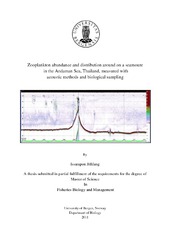| dc.description.abstract | Studies of abundance and distribution of zooplankton with acoustic instruments is new methodology in Thailand. In order to evaluate if the zooplankton could be detected and measured, a specific area around a seamount in the Andaman Sea was selected for comparative measurements zooplankton with acoustics and with biological sampling. The survey was conducted with the Andaman Sea Fisheries Research and Development Center vessel RV Pramong 4" in 3 cruises during the southwest monsoon period from 14th-17th of August, 14th-17th of September and 26th-30th October 2010 working both during day and night. The survey area covered the Hin Muang-Hin Daeng seamount located on southeast part of Krabi province between 07o 08.98′ N and 98o 49.41′ E. The acoustic surveys used SIMRAD EK60 echo sounder with split beam transceivers at 38 and 200 kHz. The acoustic data were collected on four transects crossing the seamount in a star" pattern. The distance of each transect is 6 nautical miles. The biological data was collected at 2 sampling sites placed on transect line 3 of acoustic sampling: Site 1 was relatively near to the seamount, at 0.5 nautical miles distance, and Site 2 far from the seamount at 1.5 nautical miles distance. Two sampling gears were used to study the abundance and distribution of zooplankton. The Bongo net with 330 μm mesh size equipped with a flow meter and depth sensor was the main gear for studying of mesozooplankton and fish larvae. The Van Dorn 20 liters water sampler was applied for studying of microzooplankton. Both gears were used to take several samples in the vertical. Salinity, temperature, dissolved oxygen, pH, sea current speed and direction were recorded at both sites, using a CTD and a current meter. The results showed that the environmental parameters; dissolved oxygen (2.49-4.49 mg/l), temperature (28-30oC), salinity (32.00-33.43 psu) and pH value (8.28-8.52) around the seamount was quite stable throughout the sampling period. The ocean current during the period flowed cyclically in an east western direction. The density of plankton-like targets around seamount evidently varied around the pinnacle area, the horizontal distribution in September and October showed similar pattern at all transect lines with a sharp decreased density at pinnacle area at both frequencies. The same pattern was seen in some of the August transects. The acoustically measured abundance of zooplankton (copepods) at the area outside the pinnacle area was higher than at the pinnacle area throughout study period with mean abundance 54.50±19.60 kg/m2 and 44.23±22.02 kg/m2, respectively. From these high numbers, and from the comparative biological studies, the echoes scrutinized as zooplankton could not have been zooplankton, and the main smoke-like targets and layers must have been gas bearing phytoplankton rather than echoes from zooplankton. Almost all (98%) of the fish was found closer than 0.1 nautical miles from the pinnacle of the seamount. The biomass of fish was estimated to be approximately 18±9.90 tons. The abundance of zooplankton from the Bongo nets showed no difference between Sampling Site 1 (46-471 individuals/m3) and Site 2 (40-564 individuals/m3) Also, there was no significant difference between day and night sampling. The zooplankton dry weight biomass from the Bongo net collection ranged from 0.0020-0.0184 mg/m3 at Sampling Site 1 and 0.0021-0.0170 mg/m3 at Site 2. Additionally, the abundance of microzooplankton, studied with the Van Dorn sampling gear indicated no difference between Sampling Site 1 (550-6100 individuals/m3) and Site 2 (1000-6900 individuals/m3) during day and night. Copepoda were the most abundant taxon accounting for 70-79% of total zooplankton densities all both gears and both sampling sites. The main reason for the difference in the numerical abundances observed with the two sampling gears is animal size. The results from the zooplankton abundance investigations showed low correlation between acoustic measurements and biological sampling. The result indicates that there are significant errors involved, problems and limitations in the acoustic detection of the main zooplankton groups, but also with the two biological sampling devices. However, the results also indicate that the zooplankton densities are very low in the study area of the Andaman Sea. Using only the 38 kHz and 200 kHz echo sounder frequencies made it therefore difficult to distinguish zooplankton on the echograms and to separate them from other masking targets. | en_US |
